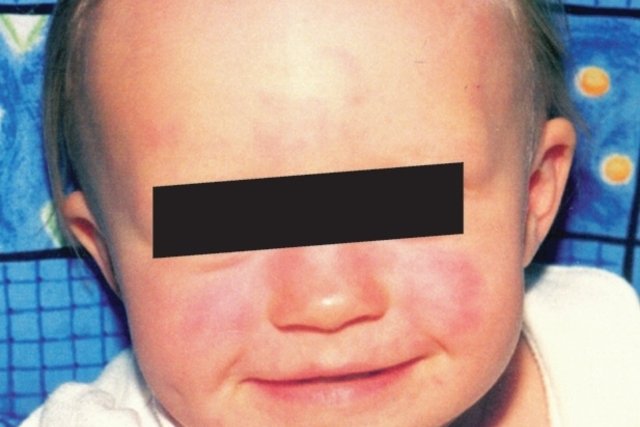Erythema infectiosum, also popularly known as slap disease or slap syndrome, is an infection of the airways and lungs, which is very common in children up to the age of 15 and causes the appearance of red spots on the face, as if the child had received a slap.
This infection is caused by the virus Parvovirus B19 and, therefore, can also be known scientifically as parvovirus. Although it can happen at any time, erythema infectiosum is more common in winter and early spring, especially due to its form of transmission, which occurs mainly through coughing and sneezing.
Erythema infectiosum can be cured and treatment normally only includes rest at home and correct hydration with water. However, if there is a fever, it is important to consult a general practitioner or a pediatrician, in the case of children, to start using medication to reduce body temperature, such as Paracetamol, for example.

Main symptoms
The first symptoms of erythema infectiosum are usually:
- Fever above 38ºC;
- Headache;
- Runny nose;
- General malaise.
Since these symptoms are not very specific and appear in winter, they are often confused with the flu and, therefore, it is relatively common for the doctor to not give it much importance at first.
However, after 7 to 10 days, the child with erythema infectiosum develops the characteristic red spot on the face, which ends up facilitating the diagnosis. This spot has a bright red or slightly pink tone and mainly affects the cheeks of the face, although it can also appear on the arms, chest, thighs or butt.
In adults, the appearance of a red spot on the skin is rarer, but it is common for joint pain, especially in the hands, wrists, knees or ankles.
How to confirm the diagnosis
Most of the time, the doctor can make the diagnosis just by observing the signs of the disease and evaluating the symptoms that the person or child can describe. However, as the first signs are not very specific, it may be necessary for the skin spot or joint pain to appear to confirm the diagnosis of erythema infectiosum.
However, if the infection is highly suspected, the doctor may also order, in some cases, a blood test to identify whether there are specific antibodies to the disease in the blood. If this result is positive, it indicates that the person actually has erythema infectiosum.
How transmission happens
Erythema infectiosum is quite contagious, as the virus can be transmitted through saliva. Therefore, it is possible to catch the disease if you are close to an infected person or child, especially when you cough, sneeze or release saliva when talking, for example.
Furthermore, sharing utensils, such as cutlery or glasses, can also lead a person to develop erythema infectiosum, as simple contact with infected saliva also transmits the virus.
However, this transmission of the virus only occurs in the first days of the disease, when the immune system has not yet managed to control the viral load. Therefore, when the characteristic spot appears on the skin, the person is normally no longer transmitting the disease and can return to work or school if they feel well.
How the treatment is carried out
In most cases, specific treatment is not necessary, as there is no anti-virus capable of eliminating the virus. Parvovirus and the immune system itself can completely eliminate it after a few days.
Therefore, ideally, the person with the infection should rest to avoid excessive tiredness and facilitate the functioning of the immune system, as well as maintain adequate hydration by drinking fluids throughout the day.
However, as the infection can cause a lot of discomfort, especially in children, it is usually advised to consult a general practitioner or pediatrician to start treatment with painkillers, such as Paracetamol.

Sign up for our newsletter and stay up to date with exclusive news
that can transform your routine!
Warning: Undefined array key "title" in /home/storelat/public_html/wp-content/plugins/link-whisper-premium/templates/frontend/related-posts.php on line 12
Warning: Undefined array key "title_tag" in /home/storelat/public_html/wp-content/plugins/link-whisper-premium/templates/frontend/related-posts.php on line 13



